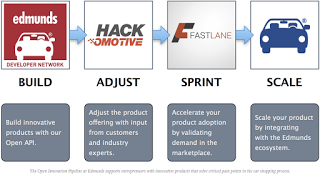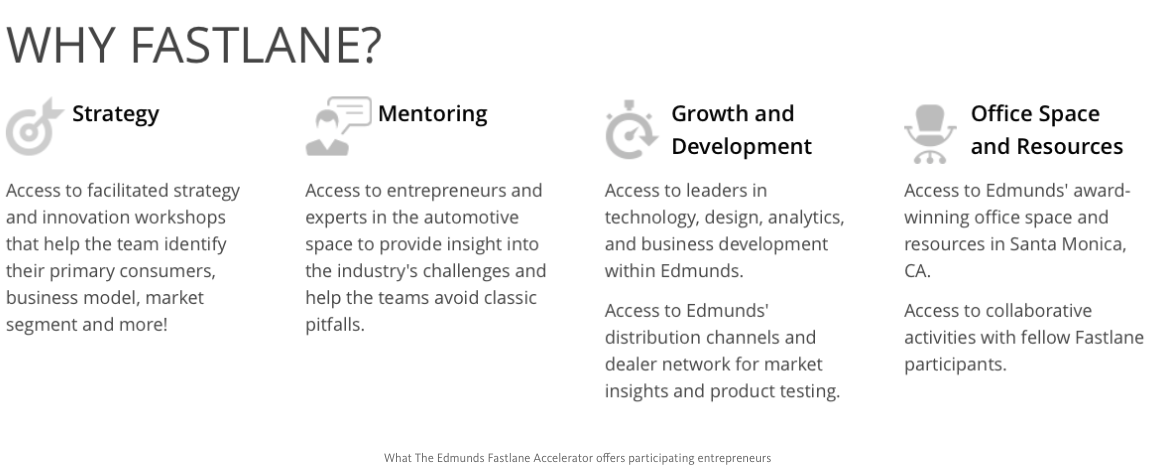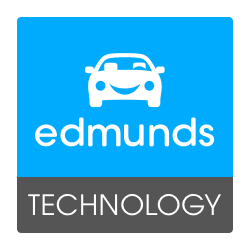Creating Innovation Paths at Edmunds
Ismail Elshareef, Executive Director of Open Platforms, recently published an article regarding the history behind our innovative Hackomotive and Fastlane programs. Why does this matter? Well it got Edmunds.com on the World’s Top 10 Most Innovative Companies of 2015 in Automotive list for starters. But we didn’t create these innovation platforms for the recognition. We created these innovation paths to identify new ideas in the automotive marketplace to increase our success. To understand more about the trials and learnings from where we started in the innovation process to where we are now, read below.
Annals of Open Innovation
How Edmunds.com Built a Framework to Discover, Accelerate and Scale Breakthrough Automotive Ideas

Fast Company named Edmunds.com one of The World’s Top 10 Most Innovative Companies of 2015 in Automotive. It cited Hackomotive and the Fastlane Accelerator as two reasons why the company made the list. Aside from Edmunds, Apple, Tesla and Google, every company on that list was an automotive manufacturer like Toyota and GM.
To be recognized for something we’ve been so deliberate with and focused on is gratifying. Seeking out entrepreneurs who are using our data to build great products, help them validate their product/market fit and then scaling them has proven to be a great strategy for us to leapfrog our product offerings, thus our growth.
But that didn’t happen overnight. In fact, it took us four years to get where we’re at today. Let’s start from the very beginning.
An API Story
In September 2011, we launched our Open Platform with high hopes and no clear expectations. We had a hunch that opening the APIs that power our site and mobile app to the public would help spur innovation and expedite partnership integrations. We couldn’t really quantify the opportunity at the time, but we believed that one existed.
With Mashery’s help, we were able to put the word out fast. Pretty quickly, we saw engagement from developers with strong vision for making our industry better. Some with grandiose ideas of disrupting the car dealerships and others with more strategic focus on consumer-facing products.
Developers signed up. Applications were created. Data was consumed.
The platform was working.
A few months after we launched, we noticed that one of the developers had built a widget that was getting high engagement on car dealership websites. We got in touch with him to talk scale. A few months later, we helped put his widget on thousands of dealership websites for a monthly fee.
That’s a multi-million dollar opportunity for the company, and a great payday for the developer.
Home run. We got lucky.
But even with 10,000+ developers on our network today, we never saw that type of organic breakout success again. There’s a ton of great potentials, but no clear standouts.
So we decided to be more deliberate about finding the next scalable ideas, or at least the ones with such potential. That’s where Hackomotive came into play.
Hackomotive
A Hackathon With a Purpose
In 2013, we put on our very first Hackomotive event. Our objective was to tap into the wisdom of the crowd to solve the pressing challenges around car buying. Coding wasn’t the emphasis. Finding solutions was. The event was a success. The objective was met.
However, everything ceased with the end of the event. Sure, we announced three winners, there was press, happy hour was popular, but once the event was over, the participants driving those ideas went back home. Back to their lives.
Back to their jobs.
Great ideas cannot survive without someone consistently driving them forward with vision, conviction and passion.
With that realization, we decided to change the format of Hackomotive to focus solely on existing products and prototypes that are addressing current challenges in the car shopping process. To find those products and prototypes, we reached out to our API developer community, and to other entrepreneurs on social media.
In 2014, eleven out of the twelve participating teams came from the API developer community.
We had another successful event. Far better than the first one. The entrepreneurs received valuable feedback on their products from real customers as well as investors, industry experts, and other business leaders.
This time, momentum did not cease with the end of the event. We knew we needed to follow through with some of these products.
So we created Fastlane.
Fastlane Accelerator
The Product/Market Fit Acceleration
Coming out of Hackomotive 2014, we identified several products that we thought had great potential. We ended up selecting three to take part in our very first accelerator program–Fastlane.
When we designed Fastlane, we deliberately made it different from other accelerators out there. We didn’t want to seek any equity position or intellectual property rights to any of the participating products or ideas.
Fastlane was designed to be an all-access, no-strings-attached opportunity for automotive entrepreneurs to validate their product/market fit.

Fastlane was also designed to give Edmunds the opportunity to share those great ideas with our customers and partners for feedback. Knowing what the market wants makes it easier to decide which ideas to invest in, acquire or part ways with.
Last year, we concluded Fastlane with an acquisition. It was a success. It also showed us that the open innovation pipeline we pieced together was working.
In a few weeks, we’ll kick off our 2nd annual Fastlane Accelerator program. We’re excited to see where this one leads. Will it lead to another acquisition? An investment? A partnership? A profound learning?
There are no guarantees, but the possibilities are always exciting ☺
Be part of our journey and follow us on Twitter.
We will continue to learn, tweak and change this framework to make it work better for the entrepreneurs and for us. Iteration makes perfect.
What we know for sure is that innovation requires an ecosystem to thrive. A pipeline. A framework. Having an Open Platform alone doesn’t cut it. Running a hackathon with no concrete consequences doesn’t cut it. Buying into a product without validating the product/market fit does not cut it.
Thoughts?
Do you see improvements that could be done? A better framework perhaps? Would love to read your responses.
 Ismail Elshareef is Executive Director of Open Platforms.
Ismail Elshareef is Executive Director of Open Platforms.
